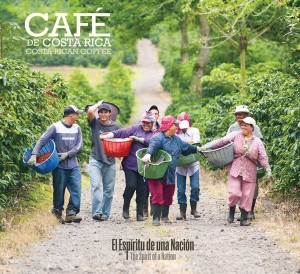An Important New Book About Coffee and Costa Rica
Costa Rica has gained a world-renowned reputation for the outstanding quality and flavors of its coffees. Indeed, Costa Rica can boast that it is as unique, diverse and widespread as any other top-ranking coffee producer in the world. But how did this happen?
Recently, ICAFE published “Café de Costa Rica / Costa Rican Coffee”, a pictorial and written history of the evolution of coffee in Costa Rica. The text is written in both English and Spanish, side by side.
I feel it is an important book because it dissects, analyses the history of coffee here from many different angles and it does so in a way that does not take a scientist to understand. The book opens with brief explanation about the geological construction of the land itself that allows it to be an ideal coffee-growing region. I found this highly interesting. The book segues into the condition of the people at the time, their basic isolation, that also welcomed this new crop and income. The history and evolution of coffee production here proceeds, with individual chapters dedicated to regions of growth. In this way, it reminds me of the grape industry in the Napa Valley, where I am from, and how unique growing techniques and micro-climates help produce a variety of qualities in the fruit.
The photography by Luciano Capelli captures the mood impeccably, the true Tico spirit of its people, the breathtaking landscape. The curators who provided historic photos, Central Bank Museum, who provided the unique, vintage coffee stamps and Alvaro Castro Harrington who allowed the use of his incredible correo/café stamp collection, I feel, reveal the collective national pride in the history of coffee in Costa Rica.
The subtitle for the book is “El Espiritu de una Nacion / The Spirit of a Nation” and I believe this small phrase encompasses the importance of coffee in this small Central American country and the social impact it has had. Unlike the Banana Exploitation that occurred here and throughout Central America by outside companies, coffee in Costa Rica has been grown from the grass-roots level, by local landowners and businessmen. It’s the Costa Rican way. It helped implement the country to become a democracy. As Yazmin Ross and Jaime Gamboa, the authors of this book, are quick to point out, “Independence and coffee arrived hand in hand” to Costa Rica.
Costa Rica’s famous El Teatro Nacional, the erection of its first university and for its capitol to become the fourth city of its size to be illuminated electrically, after only Paris, New York and London, are direct results of the coffee production here. The same can be said of the completion of its cross-national train system.
The visual presentation: the breath-taking photos, the historic memorabilia, along with the complete overview of the text present a stunning result. The impact of coffee in Costa Rica has been a huge contributor to the evolution of its people. There have been books in the past about coffee, about the people, about the history of Costa Rica. But none have hit the “tuning fork” like this one. Congratulations to all the people involved on this team effort!
“Café de Costa Rica” is available at Jaime Peligro book store.


